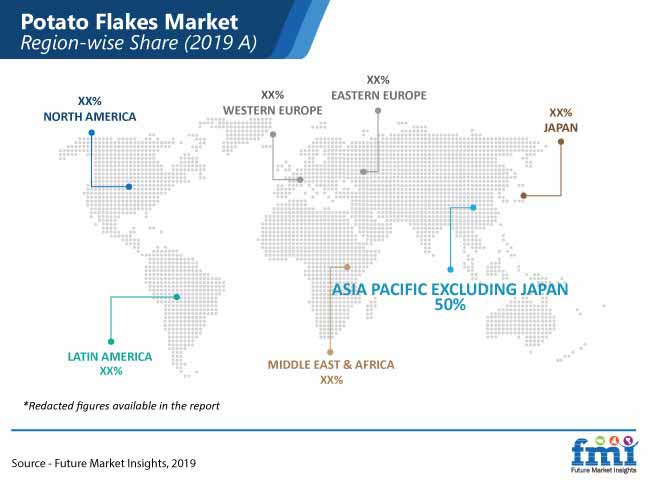The global potato flakes market was valued at US$ 17,103.8 Mn in 2019. The market has exhibited a considerable rise during 2013 -2018 and the trend is likely to continue as the market exhibits a CAGR of 7% between 2019 and 2029. The rising demand for snacks that among all age groups is aiding the growth of the market.
Increasing launches and development of major brands of potato flakes are anticipated to drive the overall growth of the potato flakes market. Leading manufacturers are focusing on expanding their footprint in regions apart from the U.S. Increasing penetration of established manufacturers ensures a competitive market scenario, and results in the launch of numerous variation in potato products that is estimated to push the overall market growth. Additionally, due to the increasing penetration of social media platforms, customers have awareness about several international brands. Manufacturers in the market including Bob’s Red Mill and McCain Foods Limited are well-known for their premium products, including potato flakes. These brands pay substantially on branding and advertisements via online and other channels, and therefore. Their marketing strategies are key drivers of potato flakes sales.
“The rising demand for extruded snacks as well as bakery products is anticipated to boost the market for potato flakes in the forecast period. Key players are adopting diverse strategies to maintain a strong foothold in the potato flakes market.” says an FMI analyst.
Request a report sample to gain comprehensive market insights @ https://www.futuremarketinsights.com/reports/sample/rep-gb-6077
Key Takeaways from Potato Flakes Market Study
- According to FMI study’s on the potato fakes market, a large consumer base is looking for products that are naturally sourced. Potato flakes are generally used in dishes that require mashed potatoes. Potato flakes are used as a thickener or base for the preparation of ready-to-eat vegetable gravies and soups. They are also used as an ingredient for potato chips, texturized potato products, snack pellets, etc. Thus, the demand for Potato Flakes is surging.
- The global potato flakes market has been segmented based on end-use, where the buyer to consumer segment holds the major share. However, in the upcoming period, the buyer to buyer segment is estimated to show a positive growth due to its increasing applications in different food products.
- Based on nature, the global potato flakes market is segmented into organic and conventional types. Due to growing health concern, consumers are looking for products that are grown naturally and are free from chemicals and are not genetically modified.
- Eastern Europe and APEJ are expected to lead the global potato flakes market in terms of value. The demand for potato flakes is considerably high in North America. Western Europe is predicted to show a high growth rate in the forecast years. The Latin America market, dominated by Brazil, is also exhibiting high demand for potato flakes.

Who is winning?
Idahoan Foods, McCain Foods Limited, Nestle S.A., Inc., Clarebout Potatoes NV, Goodrich Cereals, Lamb Weston Holdings, Inc., Iscon Balaji Foods Pvt Limited, Lutosa SA, Patwary Potato Flakes Ltd., Bem Brasil Alimentos LTDA, Rixona B.V., Agrarfrost GmbH & Co. KG, Nahr-Engel GmbH, Basic American Foods, Inc., Bob’s Red Mill Natural Foods are some of the key market players.
For Information On The Research Approach Used In The Report, Ask Analyst @ https://www.futuremarketinsights.com/ask-question/rep-gb-6077
Leading companies operating in the potato flakes market are aiming at regional expansion via targeting the local distributers to upscale their potato flakes sales and to provide high-quality products to the customers.
- In March 2018, Nestle S.A. opened a new quality assurance lab in Araras, Brazil. The move was intended to enhance the company’s organic product portfolio in the region. The company invested around US$ 6.9 Mn to construct the new facility. The quality assurance facility will ensure that its organic products are free from pesticides and genetically-modified organisms.
- In April 2018, McCain Foods Limited completed a strategic investment with a highly innovative agriculture company, TruLeaf Sustainable Agriculture. With this partnership, the company is expected to set new standards for efficient crop production and environmental care.
- In 2017, Lamb Weston Holdings, Inc. expanded its Richald Washington plant by 2, 90,000 square feet, increasing its production capacity by approximately 300 million pounds annually.
Find More Valuable Insights into Potato Flakes Market
Future Market Insights, in its new offering, provides an unbiased analysis of the global potato flakes market, presenting historical demand data (2013-2018) and forecast statistics for the period from 2019-2029. The study divulges compelling insights into the potato flakes market based on the end-use (B2B & B2C), nature (Organic & Conventional), across seven key regions.